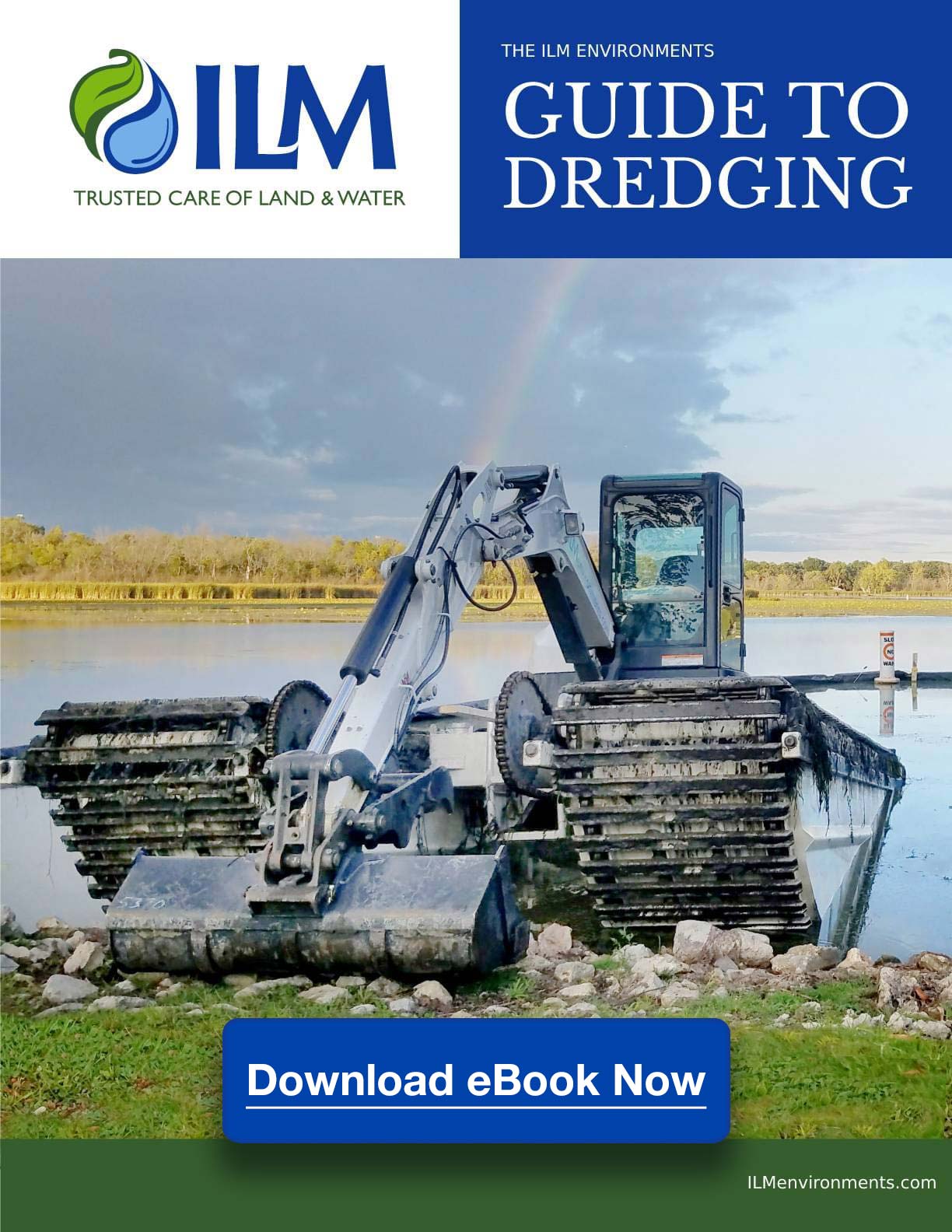Sediment Investigation
& Dredging
Service:
Sediment Investigation & Dredging
What is Sediment Build Up and Why Do I Need A Sediment Investigation?
All lakes and ponds have a natural life span and fill up with sediment over time. Sediment accumulation can be accelerated by shoreline erosion, runoff, or the seasonal buildup of organic material like submerged aquatic plants and leaves from trees. Eventually, every lake and pond require the sediment to be removed and needs to be dredged in order to maintain their intended use, whether its recreation or stormwater storage.
What Does A Sediment Investigation Involve?
A sediment investigation tells us how much sediment buildup there is in your lake or pond. It includes a bathymetric survey, which is an underwater topographical survey of the bottom of water body. It involves measuring the depth of water and the amount of sediment present before we reach the original, hard bottom. We collect data points throughout the waterbody using either sonar or sediment probing poles, or both, depending on conditions, and GPS track data collection points for future reference. We use ESRI ArcMap software to create bathymetric, sediment thickness, and total depth maps and to calculate sediment volumes in order to make recommendations on how much lake sediment removal is necessary.
Dredging
When a sediment investigation reveals that your lake or pond has an unhealthy accumulation of sediment, we typically recommend dredging. Dredging is the partial or complete removal of sediment layers rich in nutrients and organic matter. Often the goal is to return the lake or pond back to its original depth while reducing nutrients, like phosphorus, that feed alga and aquatic plants that can grow out of control. After decades of sediment accumulation, dredging is often the best option to restore a degraded lake or pond back to its beauty and function.
What Occurs During Dredging?
When a sediment investigation reveals that your lake or pond has an unhealthy accumulation of sediment, we typically recommend dredging. Dredging can be done either hydraulically or manually. Access is a big factor in determining the most appropriate dredging method for your site, and luckily, our equipment is capable of fitting in even the most congested areas.
Hydraulic dredging uses suction and is especially effective when removing loose muck. Hydraulic dredges work like a vacuum, sucking up a mixture of sediment and water and transferring it through a hose into, most often, a dewatering bag. The pond and lake sediment stays in the bag and clean water returns to the waterbody. Hydraulic dredging is limited by the onshore space to keep the dewatering bag(s). Hydraulic dredging is especially cost-effective when there is a use for the dredge material on site. Our Truxor mini-hydraulic dredge is great for dredging ponds and small lakes or doing maintenance dredging on larger bodies of water.
ILM Environment’s Guide to Dredging
Dredging is an important part of keeping a lake, pond, or other body of water clean and healthy.
Related Services
Types of Dredging
Hydraulic dredging uses suction and is especially effective when removing loose muck. Hydraulic dredges work like a vacuum, sucking up a mixture of sediment and water and transferring it through a hose into, most often, a dewatering bag. The sediment stays in the bag and cleans water returns to the waterbody. During hydraulic dredging, polymers are often used as a coagulating agent to bond suspended particles together and aid in the dewatering process. When the fine particles bond together it increases their overall mass, also called a floc, and they drop out of the water column much quicker.
Hydraulic dredging is limited by the onshore space to keep the dewatering bag(s). Hydraulic dredging is especially cost-effective when there is a use for the dredge material on site. Our Truxor mini-hydraulic dredge is great for dredging ponds and small lakes or performing maintenance dredging, especially around docks, on larger bodies of water.
Mechanical dredges work by mechanically digging sediment from the bottom using an excavator with a bucket. Mechanical dredging can be done either in the dry or “in the wet”. Dry mechanical dredging involves either partially or completely draining the pond or lake and using a long-reach excavator to scoop material from the bottom and into trucks. The material is either repurposed on-site or transported to the nearest disposal site.
We also have a specialized amphibious excavator which allows us to work farther away from shore or in difficult conditions where a traditional excavator would sink. In this case, the material is scooped into a barge or sled and then transferred into trucks and hauled away. Wet mechanical dredging does not involve drawing down the pond or lake and therefore can cause sediment resuspension. Wet mechanical dredging is done from shore or from a floating amphibious excavator.
Permitting
Regardless of how we go about dredging, regulatory permits are typically required to perform this work. ILM provides all permitting services as a part of our dredging operation. It should be noted that permitting should begin at least 3-6 months before a project is expected to begin.
Contact Us Today to Schedule a Sediment Investigation
Interested in learning more about our lake sediment removal, investigation, and dredging services? Or looking for other holistic strategies to care for your environment? Contact us today! We are happy to help you improve the beauty and health of your lake, pond, wetland, woodland, or prairie.
Do you need Sediment Investigation or Dredging Services?
ILM has current Sediment Investigation and Dredging projects in Illinois, Wisconsin, Indiana, and North Carolina .
If you are in need of sediment investigation and/or dredging services in another state, please contact us for availability.

